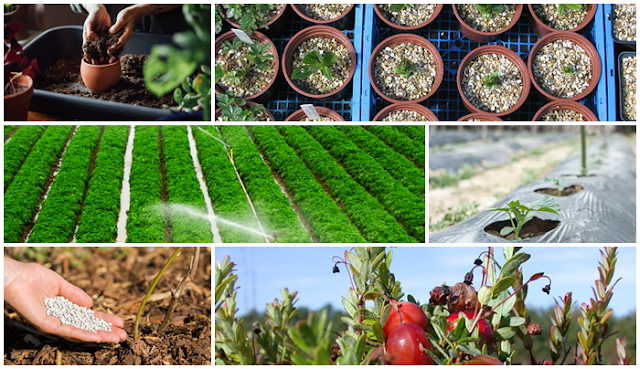Ideberries.com - Cranberries are small evergreen plants that belong to the Ericaceae family. They are native to North America and are primarily found in the northern regions of the United States and Canada.
Cranberries are low-growing shrubs that typically reach a height of about 6 to 8 inches. They have slender, wiry stems and small, glossy, dark green leaves that are leathery in texture.
One of the most distinguishing features of cranberries is their unique growth habit. They thrive in wet, acidic soils and are often found in bogs or marshy areas.
These plants have adapted to grow in such environments by developing a creeping vine-like structure called runners, which allows them to spread and form dense mats. The runners produce new upright shoots at regular intervals, forming clusters of plants known as "bunches."
Cranberry plants bloom in the spring, producing delicate pink flowers that develop into berries by late summer or early fall.
The berries are round and approximately the size of a marble, with a deep red color when ripe. They have a tart taste and are often used in a variety of culinary applications, such as sauces, juices, jams, and baked goods.
Cranberries have also gained recognition for their health benefits. They are rich in antioxidants and are a good source of vitamins C and E. Additionally, they contain compounds that may help prevent urinary tract infections and contribute to overall urinary health.
Due to their vibrant color and nutritional value, cranberries are widely enjoyed as a flavorful and nutritious addition to various dishes and beverages.
The Different Varieties of Cranberries and their Unique Characteristics
Cranberries are a group of evergreen dwarf shrubs that belong to the genus Vaccinium and are native to North America. There are several varieties of cranberries, each with its unique characteristics and uses. Here are some of the common cranberry varieties:
American Cranberry (Vaccinium macrocarpon)
This is the most widely cultivated variety of cranberries. It produces large, round berries with a deep red color.
American cranberries are known for their tart flavor and are commonly used in juices, sauces, and baked goods.
European Cranberry (Vaccinium oxycoccos)
Also known as the small cranberry or bog cranberry, this variety is native to Europe and Asia. European cranberries are smaller in size compared to American cranberries and have a more acidic and tart taste.
They are often used in traditional European dishes, jams, and jellies.
Mountain Cranberry (Vaccinium vitis-idaea)
Mountain cranberries are also called lingonberries or cowberries. They grow in cold, northern regions, including parts of North America, Europe, and Asia.
These cranberries are smaller and rounder than American cranberries, with a bright red color. They have a tangy taste and are commonly used in sauces, jams, and desserts.
Highbush Cranberry (Viburnum trilobum)
Despite the name, highbush cranberries are not true cranberries but belong to the Viburnum family. These shrubs produce clusters of bright red berries that resemble cranberries but have a slightly different taste.
Highbush cranberries are known for their tart and acidic flavor and are often used in sauces, jellies, and syrups.
Small Cranberry (Vaccinium microcarpum)
The small cranberry is closely related to the American cranberry and is native to northern regions of North America and Europe.
It produces small, round berries that are similar in taste to American cranberries, with a tart flavor. Small cranberries are used in sauces, jams, and desserts.
It's important to note that American cranberries are the most commonly cultivated variety and are readily available in most markets. Other varieties may be less common and can often be found in specialty stores or as ingredients in specific regional cuisines.
A Comprehensive Guide to Growing and Caring Cranberries
Growing and caring for cranberries can be a rewarding experience. These tart and vibrant berries thrive in specific conditions, and with the right care, you can enjoy a bountiful harvest. Here's a comprehensive guide to growing and caring for cranberries:
Climate and Soil Requirements
 |
| Photo by Gardengatemagazine.com |
Cranberries have specific climate and soil requirements for optimal growth and fruit production. Here's a description of the ideal climate and soil conditions for cranberries:
Climate Requirements
- Temperature: Cranberries thrive in cool climates. They are typically grown in regions with cold winters and moderate summers. The plants require a period of winter dormancy to promote healthy growth and fruit production. Temperatures during the growing season should range between 60°F to 85°F (15°C to 29°C).
- Frost: Cranberries are tolerant of frost and can withstand cold temperatures during the dormant period. However, late spring frosts after bud break can damage the flowers and affect fruit set.
Soil Requirements
- Acidity: Cranberries have a preference for acidic soil. The ideal soil pH range for cranberries is between 4.0 and 5.5. Acidic soil provides the necessary conditions for nutrient availability and absorption.
- Drainage: Good drainage is crucial for cranberries. They require moist conditions but cannot tolerate waterlogged soil. Cranberries are commonly grown in low-lying areas or on beds specifically designed for water management. The soil should have adequate drainage to prevent waterlogging and the development of root diseases.
- Organic Matter: Cranberries thrive in soil that is rich in organic matter. Organic matter helps retain moisture, improves soil structure, and provides essential nutrients. Incorporating compost or well-rotted manure into the soil before planting can enhance the organic matter content.
Additional Considerations
- Sunlight: Cranberries require full sun exposure to thrive. They should receive at least six hours of direct sunlight per day for optimal growth and fruit production.
- Wind Protection: While cranberries can tolerate some wind, excessive exposure to strong winds can damage the plants and reduce fruit set. Providing windbreaks or choosing sheltered growing locations can help protect the cranberry plants.
It's important to note that cranberries are often grown in specific regions that offer the ideal climate and soil conditions. Commercial cranberry production is concentrated in areas such as the northeastern United States, the Pacific Northwest, and parts of Canada, where the climate and soil conditions are favorable for cranberry cultivation. However, with proper attention to these climate and soil requirements, it is possible to grow cranberries in smaller-scale settings or in regions with similar conditions.
Plant Selection and Propagation
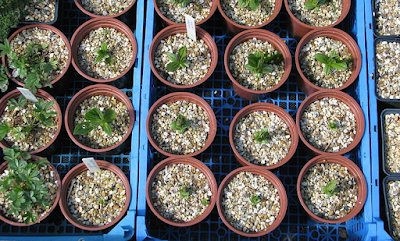 |
| Photo by wikipedia.org |
When it comes to cranberry plant selection and propagation, there are a few key considerations to keep in mind. Here's a description of the process of selecting and propagating cranberry plants:
Plant Selection
- Certified Disease-Free Plants: It's important to choose cranberry plants that are certified disease-free. This helps ensure the health and productivity of your cranberry crop.
- Reputable Nurseries: Purchase cranberry plants from reputable nurseries or suppliers that specialize in cranberry propagation. These nurseries will have experience and expertise in growing healthy cranberry plants.
- Variety Selection: Consider the variety of cranberries you want to grow. The most commonly cultivated variety is the American cranberry (Vaccinium macrocarpon), but there are other varieties available as well, such as the European cranberry (Vaccinium oxycoccos) and the mountain cranberry (Vaccinium vitis-idaea). Choose a variety that suits your climate and culinary preferences.
Propagation
Cuttings: Cranberries can be propagated using softwood or hardwood cuttings. Softwood cuttings are taken in late spring or early summer from new, flexible growth. Hardwood cuttings are taken in late fall or winter from mature, dormant branches.
- Prepare the cuttings by cutting a 6 to 8-inch (15 to 20 cm) section from healthy, disease-free branches.
- Dip the cut end of the stem in a rooting hormone to encourage root development.
- Plant the cuttings in a well-draining rooting medium, such as a mixture of perlite and peat moss.
- Keep the cuttings in a warm, humid environment and provide bottom heat to promote rooting.
- Once the cuttings have rooted (usually after a few weeks to a few months), they can be transplanted into pots or the field.
Runners: Cranberries naturally produce runners, which are long, trailing stems that root at the nodes and give rise to new plants. Runners can be used to propagate cranberries.
- Identify healthy, disease-free runners that have rooted at the nodes.
- Cut the runner between the parent plant and the rooted node, ensuring that the new plant has roots attached.
- Transplant the runner with its roots into a new location or container.
- Keep the newly transplanted runner well-watered and provide protection from extreme temperatures until it establishes itself.
It's worth noting that cranberries are commonly grown on a large scale in commercial operations. However, with proper knowledge and care, it is possible to propagate cranberries on a smaller scale for personal or hobbyist purposes. Following these guidelines for plant selection and propagation can help ensure healthy and productive cranberry plants.
Watering and Irrigation
 |
| Photo by Home.howstuffworks.com |
Watering and irrigation are crucial aspects of cranberry cultivation as cranberries require consistent moisture throughout the growing season. Here's a description of watering and irrigation practices for cranberries:
Moisture Requirements
- Cranberries are typically grown in wetland environments, such as bogs or marshes, where the soil is naturally moist.
- The goal is to maintain the soil moisture level within the root zone of the cranberry plants consistently.
- Adequate moisture is particularly important during the flowering and fruit development stages to ensure proper fruit set and growth.
Watering Methods
- There are different methods of watering and irrigation used in cranberry cultivation, including overhead irrigation and flooding.
- Overhead irrigation: This involves using sprinklers or irrigation systems to deliver water from above. Overhead irrigation can help maintain consistent moisture levels and provide cooling during hot periods.
- Flooding: Flooding is a traditional method used in cranberry cultivation. The fields are flooded with water, typically during the winter dormant period and at specific stages of the growing season. Flooding provides frost protection, aids in weed control, and can help with harvesting by floating the ripe berries to the surface.
Irrigation Scheduling
- The timing and frequency of irrigation depend on various factors, including weather conditions, soil moisture levels, and plant needs.
- Monitor the soil moisture regularly to determine when irrigation is required. One way to do this is by using soil moisture sensors or by observing the soil's visual appearance and feeling the soil for moisture.
- Generally, cranberries require about an inch of water per week, either through rainfall or irrigation. However, the specific water requirements may vary based on factors such as temperature, evaporation rates, and plant growth stage.
- During the flowering and fruit development stages, it is important to ensure adequate moisture to support fruit formation and prevent fruit shriveling.
Water Quality
- Cranberries are sensitive to water quality, particularly in terms of pH and mineral content.
- The ideal pH range for irrigation water is between 5.0 and 6.5.
- It is essential to avoid using water sources with high salt content or high levels of dissolved solids, as they can negatively impact plant health and productivity.
- If the irrigation water quality is poor, measures such as using appropriate filtration systems or adjusting the water pH may be necessary.
Proper watering and irrigation practices help ensure the health and productivity of cranberry plants. Understanding the specific moisture requirements and employing suitable irrigation methods can contribute to successful cranberry cultivation. It is recommended to consult local agricultural experts or cranberry-specific resources for region-specific guidance on watering and irrigation practices.
Mulching and Weed Control
 |
| Photo by Specialtycropindustry.com |
Mulching and weed control are essential aspects of cranberry cultivation to promote plant health, conserve moisture, suppress weed growth, and protect the berries. Here's a description of mulching and weed control practices for cranberries:
Mulching
- Mulching is the process of applying a layer of organic or inorganic material around the cranberry plants to provide various benefits.
- Organic mulches such as straw, wood chips, or pine needles are commonly used in cranberry cultivation.
- Mulching helps conserve soil moisture by reducing evaporation and suppressing weed growth.
- Apply a layer of mulch around the cranberry plants, aiming for a thickness of 2 to 4 inches (5 to 10 cm).
- Ensure that the mulch does not come into direct contact with the cranberry stems, as this can promote disease development.
- Mulch also acts as a protective barrier, preventing the cranberries from rotting when they come into contact with the soil during the growing season.
Weed Control
- Effective weed control is crucial for cranberry cultivation, as weeds can compete with the cranberry plants for nutrients, water, and sunlight.
- Weed management practices vary depending on the scale of cultivation, but some common methods include hand weeding, mechanical cultivation, and herbicide use.
- Hand weeding: Regularly inspect the cranberry beds and manually remove weeds by hand, being careful not to disturb the shallow cranberry roots.
- Mechanical cultivation: In larger cranberry fields, mechanical cultivation tools such as rotary tillers or flame weeders can be used to control weeds. This method involves disturbing the soil surface to uproot weeds.
- Herbicides: The use of herbicides should be done judiciously and in accordance with local regulations and best practices. Consult with agricultural experts or extension services to identify herbicides approved for cranberry weed control and follow the instructions for safe and effective use.
Weed-Free Strips
- Maintaining weed-free strips within the cranberry beds is a common practice.
- Weed-free strips are areas of the cranberry bed where weeds are actively managed or removed, typically using mechanical cultivation or herbicides.
- These strips allow for easier access to the cranberry plants, improve air circulation, and reduce weed competition around the cranberries.
Timing and Regular Maintenance
- Weed control measures should be implemented early in the growing season and continued throughout the year as necessary.
- Regularly inspect the cranberry beds to identify and address weed growth promptly.
- Mulch should be replenished as needed to maintain the desired thickness and effectiveness in suppressing weed growth.
Effective mulching and weed control practices are crucial for the successful cultivation of cranberries. They help ensure that the cranberry plants have access to sufficient resources and reduce competition from weeds, ultimately contributing to healthier plants and higher yields. It is advisable to consult with local agricultural experts or cranberry-specific resources for region-specific guidance on mulching and weed control methods.
Fertilization
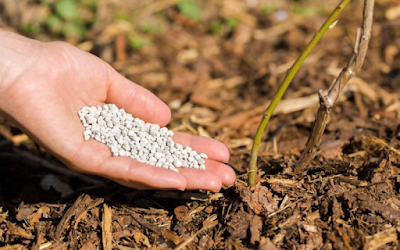 |
| Photo by Blog.jungseed.com |
Fertilization is an important aspect of cranberry cultivation to provide the necessary nutrients for optimal growth, fruit production, and plant health. Here's a description of cranberry fertilization practices:
Soil Testing
- Before applying fertilizers, it is crucial to conduct a soil test to determine the nutrient status and pH of the soil.
- Soil testing helps identify any nutrient deficiencies or imbalances, allowing for targeted fertilizer application.
Nutrient Requirements
- Cranberries have specific nutrient requirements, with nitrogen (N), phosphorus (P), and potassium (K) being the primary macronutrients.
- Nitrogen: Cranberries have a relatively low nitrogen requirement compared to other crops. Excessive nitrogen can lead to excessive vegetative growth, reduced fruiting, and increased vulnerability to diseases. The specific nitrogen requirements can vary based on factors such as soil type, variety, and growth stage.
- Phosphorus and Potassium: Phosphorus and potassium are essential for root development, overall plant growth, and fruit quality. The specific phosphorus and potassium requirements can also vary based on soil conditions and plant needs.
Fertilizer Application
- Fertilizer application should be based on soil test results and the specific nutrient requirements of the cranberry plants.
- Slow-release fertilizers are commonly used in cranberry cultivation to provide a gradual and sustained release of nutrients over time.
- Fertilizers should be applied evenly and distributed throughout the cranberry bed, avoiding direct contact with the cranberry stems to prevent potential burn.
- Timing of fertilizer application can vary depending on factors such as the growth stage, weather conditions, and regional practices. Generally, fertilizers are applied in early spring before new growth begins.
Organic Matter
- Organic matter plays a crucial role in cranberry cultivation as it helps improve soil structure, water-holding capacity, and nutrient availability.
- Incorporating organic matter into the soil, such as compost or well-rotted manure, can help provide additional nutrients and enhance soil fertility.
Additional Considerations
- Calcium and magnesium are secondary macronutrients important for cranberry plant health. Soil test results can help determine if additional supplementation is needed.
- Micronutrients, such as iron, manganese, zinc, and copper, are also essential for cranberry growth and development. If micronutrient deficiencies are identified, foliar sprays or targeted soil amendments can be used.
It is important to note that fertilization practices can vary based on regional factors, soil conditions, and specific cranberry cultivars. Consult with local agricultural experts, cranberry-specific resources, or extension services for precise fertilization recommendations based on your location and growing conditions. Regular monitoring, soil testing, and balanced fertilizer applications can help ensure proper nutrition for healthy cranberry plants and maximize fruit production.
Pest and Disease Management
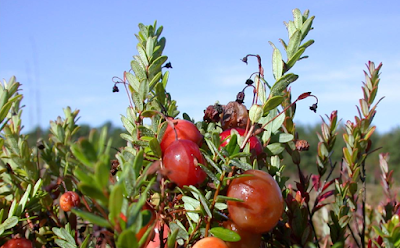 |
| Photo by Pnwhandbooks.org |
Pest and disease management is a crucial aspect of cranberry cultivation to protect the plants from potential damage and ensure a healthy crop. Here's a description of common pests and diseases of cranberries and methods for managing them:
Pest Management
- Cranberry Fruitworm: These pests can cause significant damage by feeding on cranberry flowers and fruit. Monitoring traps and applying appropriate insecticides during the vulnerable periods can help control fruitworm populations.
- Cranberry Weevil: Weevils can cause damage to cranberry buds, flowers, and developing fruit. Insecticides and cultural practices, such as removing nearby weed hosts, can help manage weevil populations.
- Aphids: Aphids can infest cranberry plants and cause feeding damage. They can be controlled through natural predators, insecticidal soaps, or targeted insecticides.
- Sparganothis Fruitworm: These pests feed on cranberry fruit, causing damage. Monitoring traps and applying appropriate insecticides during the susceptible stages can help manage fruitworm populations.
- Other pests: Additional pests that may affect cranberries include cranberry tipworm, cranberry girdler, and cranberry rootworm. Integrated pest management (IPM) practices, which combine cultural, biological, and chemical control methods, are often employed to manage these pests effectively.
Disease Management
- Fruit Rots: Fruit rot diseases, such as fruit rot caused by the fungus Colletotrichum spp., can lead to significant yield losses. Cultural practices like improving drainage, maintaining proper plant spacing, and removing infected fruit can help manage fruit rot diseases. Fungicides may also be used if necessary.
- Leaf Spot: Leaf spot diseases, caused by fungi such as Mycosphaerella spp., can affect cranberry foliage. Regular scouting, removal of infected leaves, and fungicide application as needed can help manage leaf spot diseases.
- False Blossom: Cranberry false blossom is a viral disease that causes distorted growth and reduced fruit yield. Planting virus-free stock, removal of infected plants, and controlling aphid vectors can help manage false blossom.
- Root Diseases: Cranberries can be susceptible to root diseases such as Phytophthora root rot and red root rot. Proper site selection, improving soil drainage, and avoiding excessive soil moisture can help prevent these diseases.
Cultural Practices
- Proper sanitation: Removing and destroying infected plant parts, as well as keeping the cranberry beds free from debris and weeds, can help reduce the spread of pests and diseases.
- Crop rotation: Rotating cranberries with non-host crops can help break pest and disease cycles.
- Water management: Proper irrigation practices, such as avoiding excessive moisture and preventing waterlogged conditions, can help minimize disease incidence.
Integrated Pest and Disease Management
Employing an integrated approach that combines cultural practices, biological control, pest-resistant varieties, and targeted use of pesticides when necessary is the most effective strategy for managing pests and diseases sustainably.
It's important to regularly monitor the cranberry plants for signs of pests and diseases, and promptly implement control measures when needed. Consult with local agricultural experts, extension services, or cranberry-specific resources for region-specific pest and disease management recommendations.
Harvesting and Storage
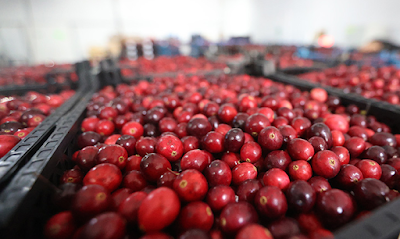 |
| Photo by Eng.belta.by |
Harvesting and proper storage practices are crucial to ensure the quality and longevity of cranberries. Here's a description of harvesting and storage methods for cranberries:
Harvesting Time
- Cranberries are typically harvested in the late summer to early winter, depending on the region and variety.
- Harvest timing depends on the desired end use of the cranberries. For fresh consumption, cranberries are generally harvested when they have reached their full color and firmness. For processing purposes, cranberries may be harvested slightly earlier.
Harvesting Methods
Wet Harvesting: The most common method of cranberry harvesting is known as wet harvesting. This involves flooding the cranberry fields with water to float the ripe berries to the surface.
- Specialized equipment, such as mechanical harvesters or water reels, is used to gently dislodge the berries from the vines.
- Floating booms or barriers are used to corral the berries, making them easier to collect.
- The floating berries are then directed into collection bins or conveyed onto a harvest boat.
Dry Harvesting: Dry harvesting involves manually picking the ripe berries from the vines without flooding the fields.
- This method is more labor-intensive and is often used for specialty or fresh-market cranberries.
- Handheld tools, such as scoops or rakes, are used to comb through the vines and separate the berries.
Sorting and Cleaning
- After harvest, the cranberries undergo sorting and cleaning processes to remove any leaves, twigs, or damaged berries.
- Modern sorting equipment uses optical scanners or vibrating screens to separate the good berries from debris.
Storage
- Cranberries can be stored using different methods, depending on the intended use and duration of storage.
- Short-Term Storage: For short-term storage of a few weeks, cranberries can be kept in perforated plastic bags or shallow containers in the refrigerator. It is important to remove any spoiled berries promptly to prevent spoilage of the remaining cranberries.
- Long-Term Storage: For longer-term storage, cranberries can be frozen. Spread the berries in a single layer on a baking sheet and freeze them. Once frozen, transfer the berries to airtight containers or freezer bags and store them in the freezer for up to a year. Freezing cranberries helps maintain their quality and allows for their use in various recipes throughout the year.
Proper harvesting and storage practices are vital for preserving the flavor, texture, and nutritional value of cranberries. Following these guidelines can help ensure that the cranberries remain fresh and suitable for consumption over an extended period.
Remember that cranberries are typically grown on a large scale, and commercial cultivation may have additional requirements and practices. However, with the right conditions and care, you can also successfully grow cranberries on a smaller scale for personal enjoyment.

